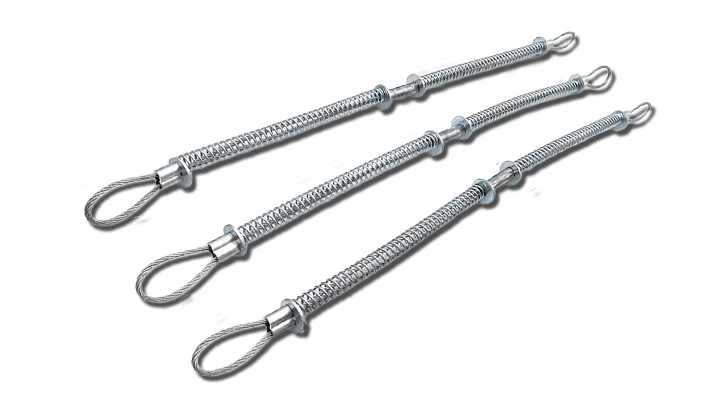VGD GripGuard Secure:
Hose Safety Restraints


- Hose safety restraints, often featuring interlocking mechanisms and high-strength materials, are designed to prevent hose whip and separation under pressure, significantly reducing the risk of injury and equipment damage.
Introducing the VGD GripGuard Secure Series:
Uncompromising Safety for Your Hose Connections
VGD is excited to announce the addition of the GripGuard Secure line to our comprehensive range of industrial solutions. This new series of high-quality cable hose safety restraints offers a vital layer of protection against the hazards of hose whip and unexpected disconnections. Available with durable cable in 1/8″, 1/4″, and 3/8″ diameters, the GripGuard Secure line provides a reliable and robust solution for securing critical fluid and pneumatic transfer systems. With the VGD GripGuard Secure, you can enhance workplace safety and minimize operational risks, ensuring dependable performance for your diverse applications. Explore the added security and peace of mind this new product line brings to your operations.
| Cable Dia. | Length Inches | Hose Diameter Inches | Product Code | Weight Lbs |
|---|---|---|---|---|
| 1/8" | 15" | 1/2" - 1 1/4" | 3317 0815 | .150 |
| 1/8" | 22 | 1/2" - 1 1/4" | 3317 0822 | .230 |
| 1/4" | 24 | 1 1/2" - 3" | 3317 1624 | .900 |
| 1/4" | 36 | 1 1/2" - 3" | 3317 1636 | 1.22 |
| 3/8" | 48 | 3 1/2" - 6" | 3317 2448 | 3.00 |
WARNING
SERIOUS RISK OF INJURY OR PROPERTY DAMAGE EXISTS IF THESE INSTRUCTIONS AND WARNINGS ARE NOT FOLLOWED.
Read and Understand All Instructions Before Installing, Using, or Inspecting VGD GripGuard Secure Cable Hose Safety Restraints.
- Intended Use Only: These cable hose safety restraints are designed to provide secondary protection against hose whip and separation in pressurized fluid and pneumatic systems. They are intended to be used in conjunction with properly installed and maintained hose assemblies and connections. These restraints are not a substitute for proper hose selection, installation, maintenance, or secure primary connections.
- Correct Size Application: Ensure the GripGuard Secure restraint selected is the correct size for the outer diameter of the hose being used. Using an improperly sized restraint may result in ineffective protection or damage to the hose. Refer to the Secure sizing chart for proper selection.
- Proper Installation is Critical: Ensure the cable is securely fastened around the hose and that the locking mechanism is properly engaged and tightened. Incorrect installation can lead to restraint failure and potential harm.
- Regular Inspection: Inspect all GripGuard Secure restraints before each use for any signs of damage, wear, corrosion, or deformation. Do not use a restraint that shows any signs of damage. Replace damaged restraints immediately.
- Pressure Limitations: Never exceed the recommended working pressure of the hose assembly. The GripGuard Secure restraint provides secondary protection but does not increase the pressure rating of the hose.
- No Modifications: Do not modify or alter the GripGuard Secure restraints in any way. Modifications can compromise their structural integrity and effectiveness.
- Trained Personnel: Installation and inspection of these safety restraints should only be performed by trained and qualified personnel who understand the hazards associated with pressurized systems.
- Disclaimer of Liability: VGD assumes no liability for injuries or damages resulting from the misuse, improper installation, lack of maintenance, or failure to follow these warnings and instructions. The user is solely responsible for ensuring the safe application and use of VGD GripGuard Secure Cable Hose Safety Restraints.
By using VGD GripGuard Secure Cable Hose Safety Restraints, you acknowledge that you have read, understood, and agree to comply with these warnings and instructions.
Keep this warning page readily accessible for all users.
The information provided herein regarding the use, installation, and maintenance of VGD GripGuard Secure Cable Hose Safety Restraints is intended as a general guide. Users are strongly advised to consult all applicable regulations and standards set forth by their regional occupational safety and health authorities, including WorkSafe in Canada and OSHA in the United States, as well as any other relevant local or industry-specific regulations. In the event of any conflict or inconsistency between this document and the requirements of such regulatory bodies, the regulations of WorkSafe, OSHA, or the applicable local authority shall take precedence.
How to Choose the Right Hand Hose Restraint?
Choosing the right size GripGuard Secure cable hose safety restraint is crucial for ensuring its effectiveness and the safety of your operations. Here’s a step-by-step guide:
1. Measure the Outside Diameter (O.D.) of Your Hose:
- Use a calliper or a flexible measuring tape to accurately measure the outer diameter of the hose you need to restrain. Measure at several points along the hose to account for any variations.
2. Consult the VGD GripGuard Secure Sizing Chart:
- VGD should provide a sizing chart that correlates hose outer diameters to the appropriate GripGuard Secure cable restraint size (likely based on the 1/8″, 1/4″, and 3/8″ cable diameters).
- This chart will specify the range of hose O.D. that each cable size is designed to accommodate safely.
3. Select the Restraint Size that Matches Your Hose O.D. Range:
- Choose the GripGuard Secure restraint where your measured hose O.D. falls within the specified range of the cable size.
- Do not choose a restraint that is too large or too small.
- A restraint that is too large may not provide a secure grip and could allow the hose to whip.
- A restraint that is too small may be difficult to install, could damage the hose, or may not be able to withstand the forces in the event of a failure.
4. Consider the Application and Pressure:
- While your cable diameters are fixed (1/8″, 1/4″, 3/8″), understand that each size will have a recommended working pressure or force resistance. Ensure the chosen size is adequate for the pressure and potential force of your hose system. Your product specifications should detail these limitations.
5. Follow Installation Instructions:
- Once you have the correct size, carefully follow the VGD installation instructions to ensure the restraint is fitted properly and securely.
Example Scenario:
Let’s say you have a hose with an outer diameter of 0.65 inches. You would then consult the VGD GripGuard Secure sizing chart. If the chart indicates that the 1/8″ cable restraint is suitable for hoses with an O.D. range of 0.5″ to 1.25″, then the 1/8″ GripGuard Secure would be the correct size for your 0.65″ O.D. hose.
Key Reminders:
- Always refer to the official VGD GripGuard Secure sizing chart. This is the most accurate way to ensure proper selection.
- If your hose diameter is close to the upper or lower limit of a size range, consider contacting VGD for guidance.
- Regularly inspect restraints to ensure they are still the correct size and in good working condition.
By following these steps, you can confidently choose the right size GripGuard Secure cable hose safety restraint for your application, contributing to a safer working environment.
maintenance for your VGD GripGuard Secure Cable Hose Safety Restraints.
To ensure the continued effectiveness and safety of your VGD GripGuard Secure Cable Hose Safety Restraints, regular maintenance and inspection are crucial. Follow these guidelines:
1. Regular Visual Inspection (Before Each Use):
- Cable Condition: Inspect the cable for any signs of fraying, kinking, cuts, corrosion, or deformation. If any damage is found, immediately remove the restraint from service and replace it.
- Locking Mechanism: Check the locking mechanism (e.g., clamp, ferrule, or other fastening device) for proper function, wear, corrosion, or damage. Ensure it engages securely and tightens appropriately.
- Overall Condition: Look for any other signs of damage or wear to any part of the restraint.
- Correct Fit: Verify that the restraint is still the correct size and fits snugly around the hose. Ensure it has not become loose or stretched.
2. Periodic Thorough Inspection (Based on Usage and Environment):
- The frequency of thorough inspections will depend on the severity of the application, environmental conditions (e.g., exposure to chemicals, extreme temperatures, UV radiation), and frequency of use. Establish a schedule for these inspections (e.g., weekly, monthly, quarterly).
- During these inspections, pay close attention to areas that may experience stress or wear.
- Ensure all components are free of debris, dirt, or other contaminants that could impede proper function. Clean the restraints as needed with a mild detergent and water, and ensure they are fully dried before reuse.
3. Proper Cleaning:
- Clean restraints with a mild soap and water solution.
- Avoid using harsh chemicals or solvents that could damage the cable or other components.
- Rinse thoroughly with clean water and allow to air dry completely before putting back into service.
4. Storage:
- When not in use, store GripGuard Secure restraints in a clean, dry environment away from direct sunlight, extreme temperatures, and corrosive materials.
- Avoid storing them in a way that could cause damage or deformation to the cable or locking mechanism.
5. Replacement:
- Immediately replace any GripGuard Secure restraint that shows signs of damage, wear, or corrosion.
- The lifespan of a restraint will vary depending on the application and environmental conditions. Establish a replacement schedule based on your experience and the recommendations of safety professionals.
- Only use genuine VGD GripGuard Secure replacement restraints of the correct size and specification.
6. Record Keeping (Recommended):
- Maintain records of inspections, maintenance performed, and any replacements made. This can help track the lifespan of the restraints and identify any recurring issues.
Failure to properly maintain and inspect VGD GripGuard Secure Cable Hose Safety Restraints can compromise their effectiveness and may lead to serious injury or property damage in the event of a hose failure.
If you have any questions or concerns regarding the maintenance of your VGD GripGuard Secure restraints, please contact VGD or a qualified safety professional for guidance.
Remember to tailor the frequency of thorough inspections to your specific operational environment and regulatory requirements in Canada. Consulting with safety experts is crucial to ensure this maintenance guidance is comprehensive and effective for your users.



